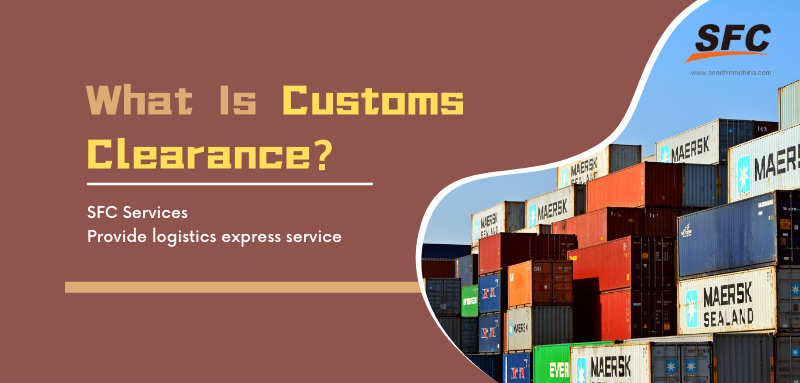Table of Contents
Get Custom eCommerce Fulfillment Service
Book a Meeting
What Is Customs Clearance?
Time: Oct 07,2023 Author: SFC Source: www.sendfromchina.com
Ever ordered a quirky gadget online, only to be told it’s stuck in ‘customs’? Ever wondered how big companies move products across borders? Customs clearance plays a pivotal role in these scenarios. Dive with me into the maze of global trade, as we decipher the nuances of customs clearance.

Related readings:
1. What Does In Transit Mean
2. Everything You Need To Know: Shipping Insurance Cost
1. What Does In Transit Mean
2. Everything You Need To Know: Shipping Insurance Cost
1. The Basics of Customs Clearance
1.2 What is Customs Clearance?
Customs clearance is the ritual dance businesses and individuals undergo when importing or exporting goods. It's the process where goods are inspected, approved, and finally allowed to enter or leave a country. Imagine it as the 'bouncer' of international trade, deciding who gets in and who stays out!
1.3 Why is it Important?
Customs clearance is a critical process in international trade and transport. It refers to the set of procedures involved in the movement of goods across borders, ensuring they meet all the regulatory requirements set by a country's customs authority. Imagine a world without customs—sounds chaotic, right? Here are several reasons why customs clearance is vital:
1.3.1 Regulatory Compliance: Every country has its own set of import and export regulations. Customs clearance ensures that goods entering or leaving a country adhere to local laws and standards, preventing the illegal import or export of goods.
1.3.2 Revenue Collection: Customs duties and taxes are a significant source of revenue for many governments. Customs clearance facilitates the proper assessment and collection of these duties and taxes.
1.3.3 Safety and Security: Customs clearance helps in identifying and stopping the transport of prohibited, restricted, or dangerous goods that could threaten a country's safety, health, or environment.
1.3.4 Trade Facilitation: Efficient customs clearance accelerates the movement of goods across borders. This speed and efficiency are crucial for businesses that rely on timely delivery, such as those operating with "just-in-time" inventory systems.
1.3.5 Protection of Local Industries: Customs clearance can also help protect local industries from unfair competition. By imposing tariffs or restrictions on certain goods, countries can ensure that local businesses remain competitive.
1.3.6 Quality Control: Customs clearance can include checking the quality of goods being imported to ensure they meet national standards. This is vital for items like food, drugs, and medical equipment.
1.3.7 Data Collection: The customs clearance process collects vital data on imports and exports, which governments and other entities can use for economic planning, trade negotiations, and statistical analyses.1.3.1 Regulatory Compliance: Every country has its own set of import and export regulations. Customs clearance ensures that goods entering or leaving a country adhere to local laws and standards, preventing the illegal import or export of goods.
1.3.2 Revenue Collection: Customs duties and taxes are a significant source of revenue for many governments. Customs clearance facilitates the proper assessment and collection of these duties and taxes.
1.3.3 Safety and Security: Customs clearance helps in identifying and stopping the transport of prohibited, restricted, or dangerous goods that could threaten a country's safety, health, or environment.
1.3.4 Trade Facilitation: Efficient customs clearance accelerates the movement of goods across borders. This speed and efficiency are crucial for businesses that rely on timely delivery, such as those operating with "just-in-time" inventory systems.
1.3.5 Protection of Local Industries: Customs clearance can also help protect local industries from unfair competition. By imposing tariffs or restrictions on certain goods, countries can ensure that local businesses remain competitive.
1.3.6 Quality Control: Customs clearance can include checking the quality of goods being imported to ensure they meet national standards. This is vital for items like food, drugs, and medical equipment.
2. The Customs Clearance Process

Documentation
First things first, you need your papers! Just as you wouldn't travel without a passport, goods can't cross borders without the correct documents. This might include invoices, packing lists, and shipping bills.
Inspection
This is the physical checking part. Just as a doctor might give you a check-up before a big trip, customs officers inspect goods to ensure they're up to snuff. Illegal substances? Banned items? They’re on the lookout!
Payment of Duties and Taxes
The finale. Once the goods are cleared, any relevant duties and taxes must be paid. Think of this as the ticket price for your goods' global adventure.
3. Common Challenges
Delayed Shipments
Ever been stuck at a traffic light that just won't turn green? That’s how delayed goods feel. Delays can arise from random inspections or paperwork hiccups.
Incorrect Documentation
A missing signature, a wrong value, or any tiny error can halt the process. It’s like missing a stamp on your visa application.
4. Tips for Smooth Customs Clearance

4.1 Working with a Customs Broker
Think of customs brokers as tour guides. They're experienced, they know the pitfalls, and they can help you navigate the complex maze of customs procedures.4.2 Understanding Regulations
4.2.1 Staying Updated
Laws change. What’s permissible today might be banned tomorrow. So, like following fashion trends, it's essential to stay updated on import/export regulations.
4.2.2 Reducing Costs and Delays
Be proactive. Anticipate potential issues, categorize goods correctly, and always double-check your documentation. Remember, prevention is better than cure!
5. The Future of Customs Clearance
Technological Innovations
Robots, AI, and blockchain are reshaping customs clearance. Automated systems might soon replace manual inspections, ensuring quicker and more accurate clearances. Ready for the future?
6. Conclusion
Customs clearance is more than just a bureaucratic procedure; it's an essential cog in the wheel of global trade. As technology progresses and the world becomes more interconnected, understanding and navigating this process will be crucial. So, next time your parcel is held up in customs, you'll know exactly what's happening behind the scenes!
FAQs
1. What documents are essential for customs clearance?
Commonly, you'll need an invoice, packing list, and shipping bill.
2. Can individuals handle customs clearance or should a broker be involved?
While individuals can manage it, using a broker often simplifies the process.
3. Why are some goods inspected while others aren't?
Some inspections are random, while others are due to suspicious documentation or nature of goods.
4. How are customs duties and taxes calculated?
They’re often based on the type and value of goods, and the regulations of the importing country.
5. Can technological advancements eliminate customs clearance?
Not eliminate, but they can simplify and accelerate the process.
 Post Views:16383
Post Views:16383
Copyright statement: The copyright of this article belongs to the original author. Please indicate the source for reprinting.
Previous Post
Top 10 Baby Care Products For Dropshipping
Next Post
TAGS
Hot Research
Get Custom eCommerce Fulfillment Service
Book a Meeting
Get a Custom China Fulfillment Solution with FREE Storage for 30 Days
 Want to know about our services, fees or receive a custom quote?
Want to know about our services, fees or receive a custom quote?
 Please fill out the form on the right and we will get back to you within a business day.
Please fill out the form on the right and we will get back to you within a business day.
 The more information you provide, the better our initial response
will be.
The more information you provide, the better our initial response
will be.





 TAGS:
TAGS: